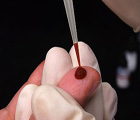 The currently used finger pricking method for monitoring blood sugar levels in diabetic patients has significant limitations, particularly in the hospital setting where it is too time consuming and costly to enable tight glycemic control and intensive insulin therapy. To this end, GlySure, a medical device company based in the UK, has developed a proprietary intravenous glucose sensor to actualize a continuous glucose monitoring system for the hospital setting that is cost effective, easy to use, and does not interfere with other procedures being performed.
The currently used finger pricking method for monitoring blood sugar levels in diabetic patients has significant limitations, particularly in the hospital setting where it is too time consuming and costly to enable tight glycemic control and intensive insulin therapy. To this end, GlySure, a medical device company based in the UK, has developed a proprietary intravenous glucose sensor to actualize a continuous glucose monitoring system for the hospital setting that is cost effective, easy to use, and does not interfere with other procedures being performed.
GlySure’s technology enables a healthcare facility to implement tight glycemic control and intensive insulin therapy, a treatment regimen that has been firmly established to provide invaluable health benefits but has previously lacked practical methods to carryout. This technology functions via a fast, non-disruptive setup that works with existing supplies and requires minimal maintenance, thereby providing a time- and cost-effective solution for continuous glucose monitoring that is currently in high need.
The strong interest in Tight Glycemic Control (TGC) can be traced to a paper published in the New England Journal of Medicine in 2001. The paper’s author, Dr. Greet Van den Berghe, showed that therapeutic compensation for temporary insulin resistance within tight normal ranges yields significant improvements in outcomes for critically ill patients.
Since 2001 there have been more than 70 additional research studies on more than 300,000 patients covering such topics as Glycemic variability, pediatric populations and the challenges of implementing TGC procedures with the current technologies.
Glucose monitoring is generally done manually by nursing staff, mainly using finger sticks and hand-held glucose meters. This practice is time consuming (up to 15 minutes per sample, including therapy adjustment) and greatly increases nurse workload.
A study conducted by Daleen Aragon on the impact of TGC implementation on nursing concluded, “Because up to 2 hours might be required for tight Glycemic control for a single patient in a 24-hour period, the costs in time and money are high.”
As a result, glucose monitoring is currently performed at a frequency that is unacceptable and could be putting patient lives at risk. Infrequent sampling significantly reduces patient care benefits while increasing the risk of hypoglycaemia. To date, the single greatest barrier to adopting TGC/IIT is the absence of an appropriate technology on the market to meet the need for tight control, ease of use, and automated monitoring.
Glysure will be presenting their technology at OneMedForum NY 2011 June 22-24.